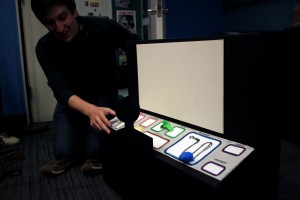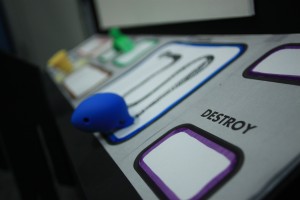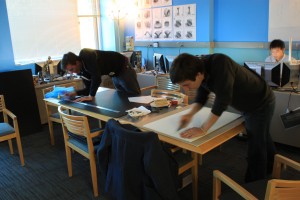Project: Take Shape
Week Five Newsletter
9-28-2012
Week Five – The Review
After an exciting week revolving prototyping our physical twist input, revising our upcoming pitch and overall direction of the project, the Take Shape team finally had our chance to show the faculty and staff of the ETC exactly what we have been doing in our room for the past four weeks. In preparation, we polished our initial prototype, built a half scale model of foam board and rehearsed a number of times.
For our initial prototype, we began by basing our inputs on the Phidget system. This system has both analog and digital components that utilize a wide variety of sensors for just about every type of observable change. In our twist input we used four touch sensors mounted to the interior sides of a box with a piece of PVC that is mounted to rotate freely in the center. Using a zip-tie and some bare speaker wire we turned the piece of PVC into a spinning touch mechanism. While the PVC spins and the wire begins to touch the sensors we can then detect the order of contact being made and therefore determine direction and speed of the twist mechanic. This information is mapped directly into the selected 3D model and applies the modifier appropriately. This, of course, is a single prototype and by the end of the semester we plan to have seven fully functional modifier inputs created. Throughout the building process we will be constantly keeping in mind the necessity for robustness in both hard- and software, form and function, as well as the ability to easily clean the machine since it will live in a children’s museum where germs are unwanted visitors.
 We additionally revised our experience/visual design packets for our third version; the version we pitched to the faculty and staff. This revision combined the two sides of our design into a seamless flow chart of how our exhibit will look, feel and function. Aside from our half scale model we have a 3D model version, that Kevin created to reflect the potential end product, and also an abstracted version which focuses on stages in the experience more than the physical attributes.
We additionally revised our experience/visual design packets for our third version; the version we pitched to the faculty and staff. This revision combined the two sides of our design into a seamless flow chart of how our exhibit will look, feel and function. Aside from our half scale model we have a 3D model version, that Kevin created to reflect the potential end product, and also an abstracted version which focuses on stages in the experience more than the physical attributes.
This quarter review was a first time experience for three of our four team members and I feel they performed well amidst the inherent pressure of such a review by extremely knowledge people. I led the presentation by introducing our team members, their roles, our client, their expectations and finally our mission statement for this semester. (This information can all be found within our website on the team, project, and client pages) Once I finished Ryan Hall took over explaining the experience design and then handed the mic to Kevin Primm who touched on some of the modifiers we hope to incorporate, our plans for a positive feedback system, a tech demo and the unveiling of our half scale mock up. To conclude, I reviewed our semester long schedule and let our guests become aware of some of the challenges or questions we are still brainstorming around in hopes to get feedback that would assist in these areas.
Sure enough, feedback is exactly what we gathered; lots of which came in regard to key areas we had yet to solidify. The biggest area in which questions or concerns arose was about the expectation of a physical takeaway from the exhibit once a child is finished. This came about due to our idea of having the children place a primitive into the machine, manipulate it yet never receive anything in return. Also, the internal logic of a machine, the exact idea we were going for, is to receive input, manipulate and proceed to output the changed item.
In order to resolve this issue we had a few choices, one being to change the entire idea but that isn’t an option at this point. Se we began to brainstorm on ways to alleviate the expectation of a takeaway. We focused on the first step of our experience in which we ask the children to place primitives of their choice into the hopper. As a team we all liked the idea of letting the kids touch, feel and play with the blocks as they please prior to digitizing them in order to drive home the idea that digital manipulation provides a platform for rapid customization that is unavailable to children while in the physical realm. To keep that tangible to digital connection while removing the insertion part we redesigned the ‘shape selector’ to resemble the gear system in a manual drivetrain of an automobile. With this design the children will still have a tangible connection as they are forced to move their choice of primitive into the center area in order to display the object on the screen. We will reinforce their choice with a myriad of colored lights, text, sounds and hopefully even tactile feedback.
 Moving forward into week six we will be tackling the fabrication of our second prototype; extrude. For this prototype, and the remaining five, we will be putting together a large shopping list of our required materials to present for a budgeting review. We will be meeting with our MAKESHOP contacts once again to deliver our new proposal with the reworked areas updated.
Moving forward into week six we will be tackling the fabrication of our second prototype; extrude. For this prototype, and the remaining five, we will be putting together a large shopping list of our required materials to present for a budgeting review. We will be meeting with our MAKESHOP contacts once again to deliver our new proposal with the reworked areas updated.